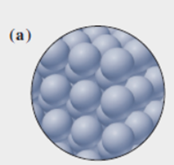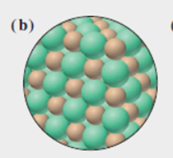
Concept explainers
(a)
Interpretation: To determine the best

Concept Introduction: A pure chemical compound made up of two or even more distinct components whereas A substance would be considered to be an element if no non-nuclear
(b)
Interpretation: To determine the best representation of the element. Compound and mixture.

Concept Introduction: Mixture will be considered as the presence of different kinds of substances.
(c)
Interpretation: To determine the best representation of the element. Compound and mixture.

Concept Introduction: A chemical element or element is any material that cannot be degraded by normal chemical processes into simpler compounds.
Want to see the full answer?
Check out a sample textbook solution
Chapter 2 Solutions
Chemistry: The Molecular Nature of Matter and Change
- Which of the following particulate illustrations represent pure substances and which represent mixtures?arrow_forward1.74 What are the two properties of ITO that make it serve its function in touch screen applications?arrow_forwardWhich of the following contains an element, a compound, and a mixture? copper, silicon dioxide(SiO2) , copper(II) sulfate(CuSO4) hydrogen, carbon dioxide(CO2) , water(H2O) chili, pizza, steak sodium, sodium chloride (NaCl). salt water nitrogen, argon, airarrow_forward
- Which of the following are chemical changes? Which are physical changes? a. the cutting of food b. interaction of food with saliva and digestive enzymes c. proteins being broken down into amino acids d. complex sugars being broken down into simple sugars e. making maple syrup by heating maple sap to remove water through evaporation f. DNA unwindingarrow_forwardAnalyses of several samples of a material containing only iron and oxygen gave the following results. Could this material be a compound?arrow_forwardWhich of the following are elements, and which are compounds? a NaOH; b BaCl2; c He; d Ag; e Fe2O3.arrow_forward
- The following are properties of substances. Decide whether each is a physical property or a chemical property. a Chlorine gas liquefies at 35C under normal pressure. b Hydrogen burns in chlorine gas. c Bromine melts at 7.2C. d Lithium is a soft, silvery-colored metal. e Iron rusts in an atmosphere of moist air.arrow_forwardClassifying Matter Determine whether each of the following is a pure element, a compound, or a mixture. If it is a mixture, classify it as homogeneous or heterogeneous: a. pure salt b. helium gas c. chicken noodle soup d. coffeearrow_forward1.14 Which part of the following descriptions of a compound or element refers to its physical properties and which to its chemical properties? (a) Calcium carbonate is a white solid with a density of 2.71 g/cm. It reacts readily with an acid to produce gaseous carbon dioxide. (b) Gray powdered zinc metal reacts with purple iodine to give a white compound.arrow_forward
- If iron filings are placed with excess powdered sulfur in a beaker, the iron filings are still attracted by a magnet and could be separated from the sulfur with the magnet. Would this combination of iron and sulfur represent amixtureor apure substance?arrow_forwardClassify each of the following as a mixture or a pure substance. a. water b. blood c. the oceans d. iron e. brass f. uranium g. wine h. leather i. table salt Of the pure substances, which are elements and which are compounds?arrow_forwardParacelsus, a sixteenth-century alchemist and healer, adopted as his slogan: "The patients are your textbook, the sickbed is your study. Is this view consistent with using the scientific method?arrow_forward
 Introductory Chemistry: An Active Learning Approa...ChemistryISBN:9781305079250Author:Mark S. Cracolice, Ed PetersPublisher:Cengage Learning
Introductory Chemistry: An Active Learning Approa...ChemistryISBN:9781305079250Author:Mark S. Cracolice, Ed PetersPublisher:Cengage Learning World of Chemistry, 3rd editionChemistryISBN:9781133109655Author:Steven S. Zumdahl, Susan L. Zumdahl, Donald J. DeCostePublisher:Brooks / Cole / Cengage Learning
World of Chemistry, 3rd editionChemistryISBN:9781133109655Author:Steven S. Zumdahl, Susan L. Zumdahl, Donald J. DeCostePublisher:Brooks / Cole / Cengage Learning Chemistry for Today: General, Organic, and Bioche...ChemistryISBN:9781305960060Author:Spencer L. Seager, Michael R. Slabaugh, Maren S. HansenPublisher:Cengage Learning
Chemistry for Today: General, Organic, and Bioche...ChemistryISBN:9781305960060Author:Spencer L. Seager, Michael R. Slabaugh, Maren S. HansenPublisher:Cengage Learning Chemistry by OpenStax (2015-05-04)ChemistryISBN:9781938168390Author:Klaus Theopold, Richard H Langley, Paul Flowers, William R. Robinson, Mark BlaserPublisher:OpenStax
Chemistry by OpenStax (2015-05-04)ChemistryISBN:9781938168390Author:Klaus Theopold, Richard H Langley, Paul Flowers, William R. Robinson, Mark BlaserPublisher:OpenStax Chemistry & Chemical ReactivityChemistryISBN:9781133949640Author:John C. Kotz, Paul M. Treichel, John Townsend, David TreichelPublisher:Cengage Learning
Chemistry & Chemical ReactivityChemistryISBN:9781133949640Author:John C. Kotz, Paul M. Treichel, John Townsend, David TreichelPublisher:Cengage Learning





